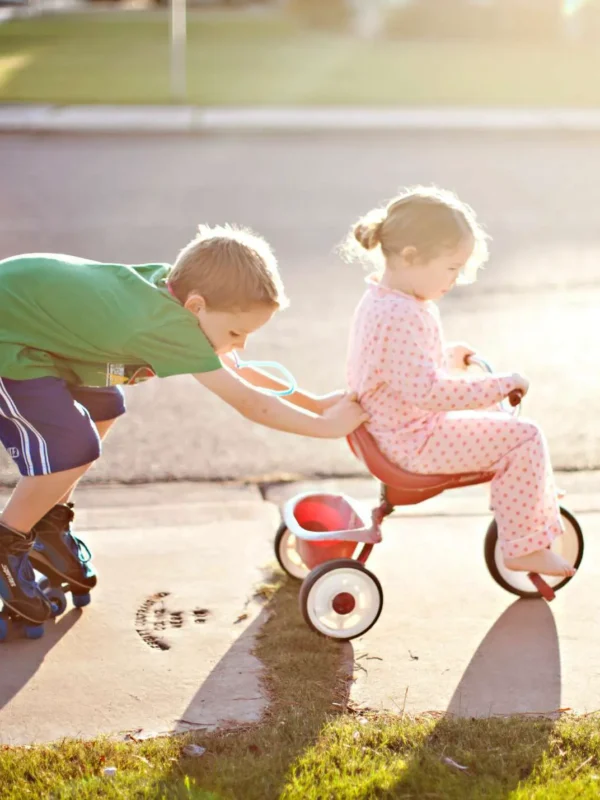
When it comes to parenting, few topics get as much attention as behavior, and for good reason. Every parent wants their child to grow into a kind, resilient, and functional adult. Naturally, questions arise:
- How do we encourage the behaviors we want to see more of, like sharing, taking turns, and helping others?
- How do we reduce behaviors we want to see less of, like hitting, whining, bragging, and teasing?
While these questions are important, the real path to better behavior starts with reframing how we think about behavior in the first place.
In this article, I’ll share two critical mindset shifts that can transform the way you approach your child’s behavior.
Reframe #1: Behaviors Don’t Stand Alone; They’re Connected to Underlying Emotions
It’s easy to focus only on the behavior you see in front of you – the teasing, whining, or hitting. But these outward behaviors are often just the tip of the iceberg. Below the surface are the emotions that drive those behaviors: jealousy, frustration, sadness, or anxiety.
Why Addressing Only the Behavior Backfired
Imagine this:
Your older child teases their younger sibling repeatedly. Each time, you respond with a time-out. They come out of time-out… and tease again. The cycle repeats.
What’s going on?
You’re addressing the behavior (teasing) but missing the emotion underneath (jealousy). By focusing only on the outward action, the root cause remains unaddressed and may even grow stronger.
The Iceberg Analogy
Think of behavior like an iceberg:
- Above the water: The visible behaviors (teasing, whining, hitting).
- Below the water: The hidden emotions driving those behaviors (jealousy, fear, frustration).
If we only react to the visible tip, we’ll keep “bumping” into the same issues time and time again. To truly change behavior, we must reveal what lies beneath.
How to Apply This Shift:
- Get curious: “I wonder what’s making my child act this way?”
- Explore with your child: “I wonder if you’re feeling a little jealous of your baby brother sometimes?”
- Validate emotions: “It’s okay to feel jealous. Everyone feels that way sometimes.”
By beginning to reveal and address the emotions behind the behavior, you can help your child process their feelings and reduce the unwanted behaviors tied to them.
Reframe #2: You Don’t Encourage Better Behavior by Making Your Child Feel Worse
Many parents unintentionally resort to shame, blame, or guilt when trying to correct behavior:
- “What were you thinking?!”
- “Why would you do that?!”
- “How many times have I told you?!”
While these reactions are common, they aren’t effective. Shame and guilt aren’t long-term motivators for positive behavior change.
Why Shame-Based Discipline Backfires
When children feel shame or guilt, they may comply momentarily but don’t learn the internal skills needed for better behavior. Over time, shame can damage self-esteem and the parent-child relationship.
Instead, we want to hold boundaries with empathy, acknowledging the child’s emotions while guiding them toward better choices.
Try This Approach Instead:
- Ineffective: “What were you thinking!? How many times have I told you not to do that?”
- Effective: “What just happened is not okay. I understand you’re upset, really, I do. Still, this can’t happen. We can feel upset, yes, but not in this way.”
This approach sets firm boundaries without shaming your child. It also sends a powerful message:
- All emotions are valid (even the hard ones).
- Not all behaviors are acceptable (and there are healthier ways to express emotions).
Becoming a Parenting Detective: Look Beneath the Surface
One of the most powerful skills you can develop as a parent is to become a behavior detective – curious and calm, searching for the “why” behind your child’s actions.
How to Strengthen Your Detective Skills:
- Pause Before Reacting
- Give yourself a moment to assess the situation without rushing into discipline.
- Ask Reflective Questions
- “Why do you think it happened this way?”
- “What were you feeling before this happened?”
- Validate and Guide
- “I see you were upset because your sister didn’t share. It’s okay to feel mad. Let’s figure out what you can say to her instead of hitting.”
Key Takeaways: The Path to Better Behavior
- Behavior is an Expression of Emotion
- Look for what’s driving the behavior beneath the surface.
- Understanding, Not Shame, Encourages Long-Term Change
- Set firm boundaries with understanding, not guilt.
- Use Curiosity Over Control
- Get curious about your child’s experience instead of rushing to correct.
By implementing these simple yet powerful mindset shifts, you’ll find that behavior challenges become opportunities for growth. You’re breaking negative behavior cycles by getting to the root cause. You’re building emotional intelligence in your child, giving them tools to express and regulate their feelings. And you’re creating a stronger parent-child bond based on trust, empathy, and understanding.
Want More Step-by-Step Parenting Tools?
If you’re ready for practical strategies to improve behavior and cooperation while deepening your connection with your child, check out my online parenting courses.
In these courses, you’ll learn how to:
- Recognize and respond to the emotions behind challenging behaviors.
- Discipline with empathy and effectiveness.
- Set confident, grounded boundaries that actually work.
With real-life examples, actionable scripts, and proven techniques, these courses give you the tools to transform behavior challenges into opportunities for connection and growth.
Learn more about my online parenting courses by clicking below 👇
 Are You Over-Parenting? How Doing Less Can Help Your Child Grow More
Are You Over-Parenting? How Doing Less Can Help Your Child Grow More The 6 Parenting Principles That Will Transform Your Parenting Journey
The 6 Parenting Principles That Will Transform Your Parenting Journey



